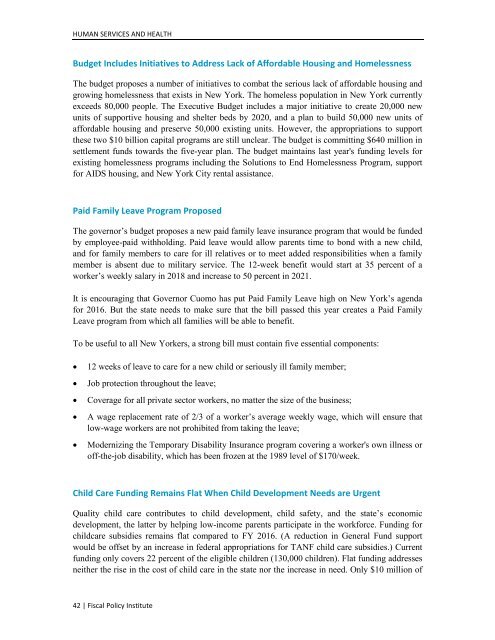2016-2017
1PSJ98W
1PSJ98W
You also want an ePaper? Increase the reach of your titles
YUMPU automatically turns print PDFs into web optimized ePapers that Google loves.
HUMAN SERVICES AND HEALTH<br />
Budget Includes Initiatives to Address Lack of Affordable Housing and Homelessness<br />
The budget proposes a number of initiatives to combat the serious lack of affordable housing and<br />
growing homelessness that exists in New York. The homeless population in New York currently<br />
exceeds 80,000 people. The Executive Budget includes a major initiative to create 20,000 new<br />
units of supportive housing and shelter beds by 2020, and a plan to build 50,000 new units of<br />
affordable housing and preserve 50,000 existing units. However, the appropriations to support<br />
these two $10 billion capital programs are still unclear. The budget is committing $640 million in<br />
settlement funds towards the five-year plan. The budget maintains last year's funding levels for<br />
existing homelessness programs including the Solutions to End Homelessness Program, support<br />
for AIDS housing, and New York City rental assistance.<br />
Paid Family Leave Program Proposed<br />
The governor’s budget proposes a new paid family leave insurance program that would be funded<br />
by employee-paid withholding. Paid leave would allow parents time to bond with a new child,<br />
and for family members to care for ill relatives or to meet added responsibilities when a family<br />
member is absent due to military service. The 12-week benefit would start at 35 percent of a<br />
worker’s weekly salary in 2018 and increase to 50 percent in 2021.<br />
It is encouraging that Governor Cuomo has put Paid Family Leave high on New York’s agenda<br />
for <strong>2016</strong>. But the state needs to make sure that the bill passed this year creates a Paid Family<br />
Leave program from which all families will be able to benefit.<br />
To be useful to all New Yorkers, a strong bill must contain five essential components:<br />
• 12 weeks of leave to care for a new child or seriously ill family member;<br />
• Job protection throughout the leave;<br />
• Coverage for all private sector workers, no matter the size of the business;<br />
• A wage replacement rate of 2/3 of a worker’s average weekly wage, which will ensure that<br />
low-wage workers are not prohibited from taking the leave;<br />
• Modernizing the Temporary Disability Insurance program covering a worker's own illness or<br />
off-the-job disability, which has been frozen at the 1989 level of $170/week.<br />
Child Care Funding Remains Flat When Child Development Needs are Urgent<br />
Quality child care contributes to child development, child safety, and the state’s economic<br />
development, the latter by helping low-income parents participate in the workforce. Funding for<br />
childcare subsidies remains flat compared to FY <strong>2016</strong>. (A reduction in General Fund support<br />
would be offset by an increase in federal appropriations for TANF child care subsidies.) Current<br />
funding only covers 22 percent of the eligible children (130,000 children). Flat funding addresses<br />
neither the rise in the cost of child care in the state nor the increase in need. Only $10 million of<br />
42 | Fiscal Policy Institute


